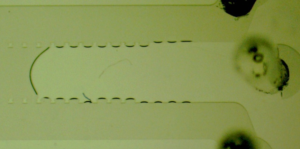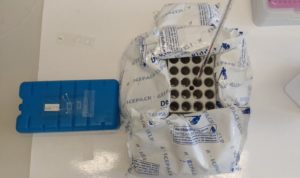Torben Roy
MeBioS biomimetics group, KU Leuven, Willem de Croylaan 42, 3001 Leuven, Belgium
Why is this useful?
Some organ-on-a-chip models require seeding of cells suspended in an extracellular matrix (ECM) such as Matrigel.1-3 When seeded inside microfluidic channels, cells experience shear stresses due to mechanical forces of the fluid which can have a negative effect on the viability of the cells.
Matrigel starts to polymerize at a temperature above 10 °C, which hinders the injection of the ECM inside microfluidic channels due to an increase in viscosity. An increase in pressure from the pipette or pump is then required and if not met, the microfluidic channel will not be fully deposited as intended (Figure 1). Precautions including the cooling of the ECM solution, pipette tips and microfluidic chip need to be taken to ensure proper deposition.
A study by Kane et al. found that a temperature between 8 °C and 10 °C is ideal for cell seeding as in this temperature range a minimal shear stress is observed.4 Below 8 °C an increase in shear stress is observed due to temperature induced liquefaction, while above 10 °C polymerization induces a higher rate of shear stress. Thus to ensure maximum cell viability, it is recommended to seed a microfluidic device with a cell-Matrigel solution in the 8 – 10 °C range. The use of an ice bath or current commercial coolers does not allow for stable cooling in that temperature range.
A new method is presented that allows for cooling of a cell-Matrigel solution in the optimal temperature window (8 – 10 °C). The cooling setup is composed out of a heating block (from a dry block heater) (or CoolRack™ from Corning), ice packs and a thermometer. Ice packs are less efficient at cooling compared to the ice bath and can be added and removed until a desired stable temperature is obtained. While the metal heating block (common lab equipment) allows for a homogeneous spread of the temperature.
Figure 1 – Unsuccessful deposition of a microfluidic chip with Matrigel. The Matrigel solution did not fill the entire main channel as intended due to premature polymerization.
What do I need?
- Heating block (e.g. modular heating block for vials, VWR) or CoolRack™ (Corning)
- Ice packs
- Cooling element
- Thermometer
- Matrigel® Basement Membrane Matrix, Phenol Red-Free, LDEV-Free (356237, Corning)
- Eppendorf tube
- Pipette
- Pipette tips
How do I do it?
- Prepare the cell-Matrigel solution in a sterile environment, aliquot in an Eppendorf tube and place on ice.
- Place the heating block, (autoclaved) pipette tips and (autoclaved) microfluidic chip inside the fridge to cool to 4°C.
- Remove the heating block from the fridge, place it on a cooling element (stable surface) and surround the heating block with ice packs.
- Place the Matrigel-cell solution and thermometer inside the heating block holes.
- Add or remove ice packs until a stable temperature in the 8 – 10°C range is achieved.
- Remove the microfluidic chip from the autoclave insert and place it on a cooling element. Inject the Matrigel-cell solution using cooled pipette tips.
Figure 2 – Cooling setup. A heating block is surrounded by ice packs to reach a stable temperature in the 8 – 10°C temperature range.
References
- Wang Y, Wang L, Guo Y, Zhu Y, Qin J. Engineering stem cell-derived 3D brain organoids in a perfusable organ-on-a-chip system. RSC Advances. 2018;8(3):1677-1685.
- Trietsch S, Israëls G, Joore J, Hankemeier T, Vulto P. Microfluidic titer plate for stratified 3D cell culture. Lab on a Chip. 2013;13(18):3548.
- Moreno E, Hachi S, Hemmer K, Trietsch S, Baumuratov A, Hankemeier T et al. Differentiation of neuroepithelial stem cells into functional dopaminergic neurons in 3D microfluidic cell culture. Lab on a Chip. 2015;15(11):2419-2428.
- Kane K, Moreno E, Lehr C, Hachi S, Dannert R, Sanctuary R et al. Determination of the rheological properties of Matrigel for optimum seeding conditions in microfluidic cell cultures. AIP Advances. 2018;8(12):125332.












